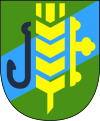Dobrzeń Wielki
Dobrzeń Wielki (Polish pronunciation: [ˈdɔbʐɛj̃ ˈvjɛlkʲi]; German: Groß Döbern [ˈɡʁoːs ˈdøːbɐn]) is a village in Opole County, Opole Voivodeship, in south-western Poland. It is the seat of the Gmina Dobrzeń Wielki (administrative district)[1] and is situated in the central district of the Opole Voivodeship, lying approximately 13 km (8 mi) north-west of the regional capital Opole. It is bordered by the Popielów municipality to the west; the Pokój municipality to the north, the Murów and Łubniany districts to the east, in addition to Opole city and the Dąbrowa and Lewin Brzeskimunicipalities to the south.[2]
Dobrzeń Wielki | |
|---|---|
Village | |
 Dobrzeń Wielki | |
| Coordinates: 50°46′N 17°52′E | |
| Country | |
| Voivodeship | Opole Voivodeship |
| County | Opole County |
| Gmina | Dobrzeń Wielki |
| Population | 4,500 |
Before 1945 the area was part of Germany (see Territorial changes of Poland after World War II).
The village has a population of 4,500.
Geography
The climate is characteristical for that of the country, with a temperature variation slightly below average. January sees temperatures between -1 and 9 degrees Celsius, in comparison to an average of 17.8 in July. The Odra River flows from the southeast to the northwest of the district, and is the area's main watercourse. This stretch is navigable and is frequently used for water transport. The river's water levels reach their highest state from February - March and July - August, whereas they are lowest from September - October. Several other waterways, such as the Mala Panew, Żydówka, Brynica, Jemielnica, Swornica, and Brzeziczanka form a vast river network in the area, in addition to numerous streams. Several ponds, oxbow lakes, and a network of canals and drainage ditches are also situated in the town's vicinity. The Brynica and Odra rivers are characterized by relatively flat surrounds, thus the Dobrzen Wielki area is susceptible to flooding. One of the town's most catastrophic floods occurred in 1997, when water submerged land on both sides of the Odra river.
History
The town's first written mentions of the town, cited as Dobren, can be derived from a document dated 1228, concerning the transfer of the Norbertine Monastery from Rybnik to the nearby village of Czarnowąs. A later document, however, dated 1279, provides the name of the town as Dobrzeń,[3] and mentions that it is part of the province of Dobrzeń. The village itself was under the possession of Kazimierz, Duke of Opole, and in 1279, was granted Magdeburg rights. In 1658, the Church of St. Roch (Kosciol Sw. Rocha) was constructed, following the invasion of the Norbertine monastery by Protestant armies in 1643.
Education
- Publiczne Liceum Ogólnokształcące w Dobrzeniu Wielkim
People
- Jan Ficek (1790–1862), born in Groß Döbern (Dobrzeń Wielki), after studies in Breslau priest in Deutsch Piekar (Piekary Śląskie)[4]
- Adolf Paul Ledwolorz (1892–1973), born in Groß Döbern (Dobrzeń Wielki), priest, author (ecclesiastical law, 1924)[5]
- Friedrich Nippert (1864–1930), teacher in Linsen (Lędzina) near Festenberg (Twardogóra), owner of the Cross of Merit for war aid in the First World War, married in Groß Döbern (Dobrzeń Wielki)[6]
- Lorenz Schwietz (1850–1925), executioner, born in Groß Döbern (Dobrzeń Wielki)[7]
References
- "Central Statistical Office (GUS) - TERYT (National Register of Territorial Land Apportionment Journal)" (in Polish). 2008-06-01.
- "Archived copy". Archived from the original on 2007-03-18. Retrieved 2010-08-12.CS1 maint: archived copy as title (link)
- Gmina tu się nazywa Dobrzeń.
- Lubos, Arno, Geschichte der Literatur Schlesiens von 1960 bis 1974, ed. 3, München: Bergstadtverlag 1974, p. 511. ISBN 978-3-87057-030-9.
- His own vita (1924): "Am 10. Januar 1892 bin ich, P. Adolf (Paul) Ledwolorz, in Groß-Döbern bei Oppeln als Sohn des verstorbenen Robert Ledwolorz und seiner Ehefrau Rosalie, geb. Gonschior, geboren. Nachdem ich die Volksschule in Chrosczütz bei Oppeln, wohin meine Eltern verzogen waren, besucht hatte, studierte ich bei den Franziskanern in Carlowitz bei Breslau. Im Jahre 1911 trat ich in den Franziskanerorden ein. Nach dem Noviziat setzte ich meine Studien an der Anstalt des Herrn Dr. Gudenatz fort und erlangte Ostern 1914 am katholischen Gymnasium zu Patschkau das Reifezeugnis. Seit dem Sommersemester 1914 studierte ich an der hiesigen Universität katholische Theologie und Philosophie. Im Januar 1915 wurde ich zum Heeresdienst eingezogen, von dem ich im Februar 1919 entlassen wurde. Ostern 1919 nahm ich mein Studium wieder auf und hörte auch Vorlesungen in der Rechtswissenschaft. Im Juni 1921 wurde ich zum Priester geweiht. Im Juli 1921 machte ich vor dem fürstbischöflichen Ordinariate das theologische Abschlußexamen. Seitdem arbeitete ich auch in der Seelsorge. Seit Oktober 1923 bin ich Lektor des Kirchenrechts im Franziskanerkloster Carlowitz." (Die das Ordensrecht betreffenden Vorschläge anläßlich des Vatikanischen Konzils und der Codex Juris Canonici, Breslau [Wrocław]: Buchdruckerei der Schlesischen volkszeitung g.m.b.h. 1924, p. 43.)
- Koerner, Bernhard (ed.), Deutsches Geschlechterbuch, ed., Gotha: C. A. Starke 1970, p. 229.
- Blazek, Matthias, Scharfrichter in Preußen und im Deutschen Reich 1866-1945, Stuttgart: ibidem 2010. ISBN 978-3-8382-0107-8.
http://www.interklasa.pl/portal/dokumenty/r023/dobrzen%20%20wielki.htm
